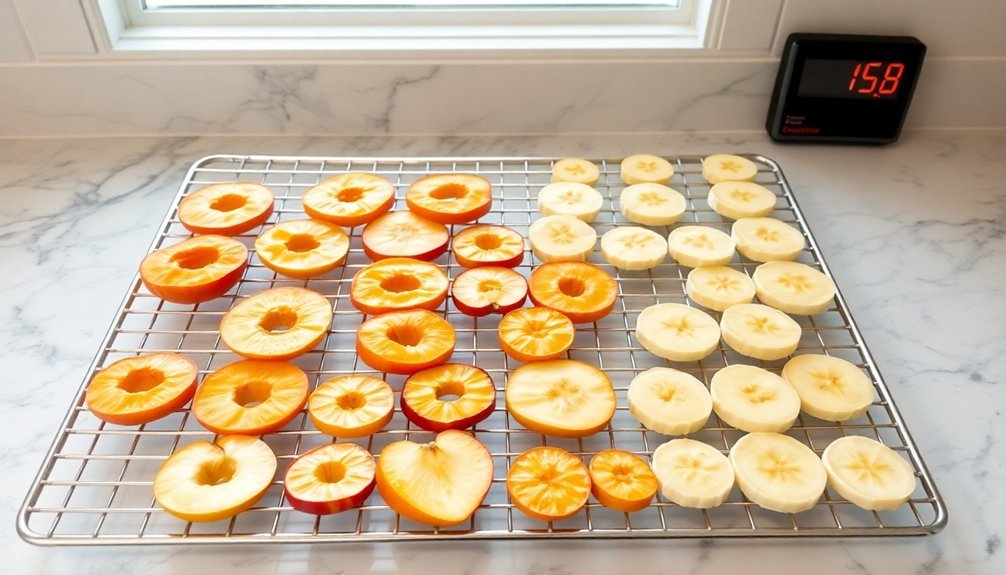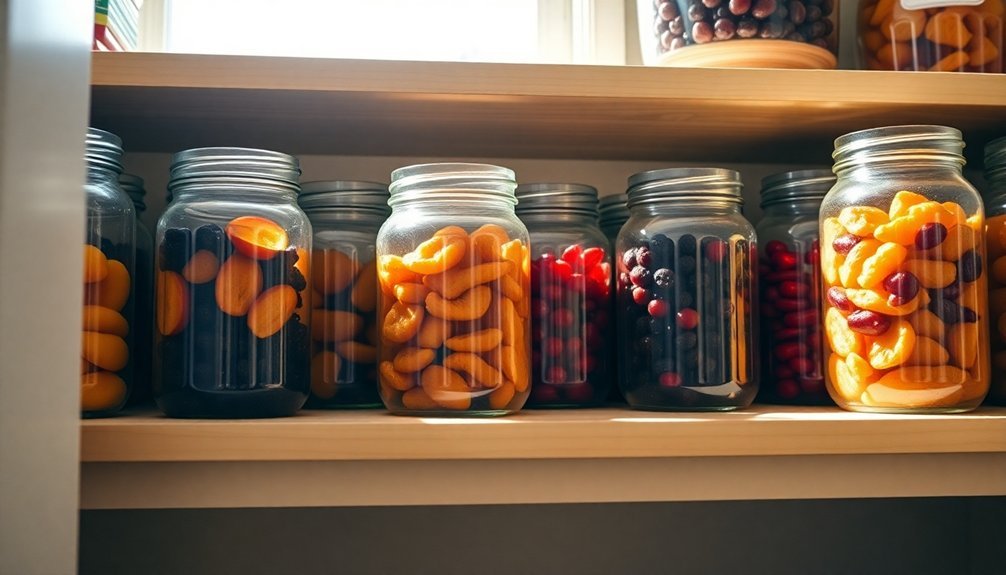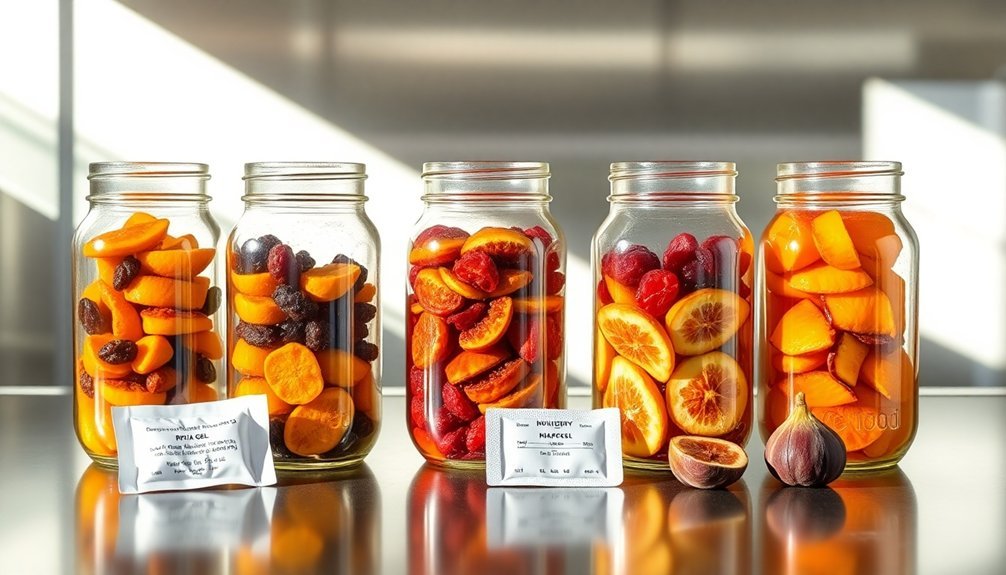Store your dried fruits properly by following these essential preservation tips. You'll need to cool them for 30-60 minutes before packaging to prevent moisture buildup and mold. Next, condition them for 7-14 days, checking daily for condensation while shaking containers for even moisture distribution. Choose airtight containers and fill them two-thirds full, storing them in a cool, dark place below 60°F. Use oxygen absorbers and vacuum sealing to extend shelf life, and monitor regularly for signs of moisture or spoilage. Consider freezing for long-term storage, and always handle with clean, dry hands. These fundamental steps will help you master the art of dried fruit preservation.
Cool Before Packaging

Patience in cooling is essential when preserving dried fruits. You'll need to allow 30 to 60 minutes for your dried fruits to reach a stable temperature before packaging them. This cooling period isn't optional – it's a vital step that prevents moisture buildup and potential mold growth in your stored fruits.
Don't rush to package your fruits while they're still warm, as this can lead to sweating inside the container. When moisture accumulates, you're creating an environment where mold can thrive, and you might need to re-dry your fruits. Watch for any signs of condensation, as this indicates your fruits haven't cooled completely.
Once your fruits have properly cooled, store them in clean, dry, insect-proof containers. Glass containers work best since you can easily spot any moisture buildup. For optimal preservation, you should use airtight containers for storage.
You'll want to keep your packaged fruits in a cool, dark place where temperatures stay at or below 60°F. Make it a habit to check your stored fruits regularly for any signs of moisture or mold. Following these cooling guidelines will help extend your dried fruits' shelf life and maintain their quality.
Master The Conditioning Process
You'll need to check your dried fruit daily for moisture by placing it in a jar and watching for any condensation on the glass.
The process usually requires a 7 to 14 days conditioning period to ensure proper preservation.
Give the container a good shake each day to help distribute any remaining moisture evenly among the fruit pieces.
If you spot any condensation forming inside the jar, return the fruit to your dehydrator for additional drying time.
Inspect Moisture Daily
Proper moisture inspection stands at the heart of successful fruit conditioning. During the 7-10 day conditioning period, you'll need to monitor your dried fruits daily to guarantee even moisture distribution and prevent spoilage.
Store your fruits in large plastic or glass containers, filling them about two-thirds full, and place them in a warm, dry, well-ventilated area. For precise moisture measurements, consider using a conductivity-based moisture meter that provides faster results than traditional oven methods.
- Check container walls and lids daily for condensation or moisture beads
- Shake or stir the contents thoroughly to separate pieces that might stick together
- Return fruit to the dehydrator if you notice any signs of excess moisture
- Keep containers covered with a cloth or tight lid to control moisture redistribution
- Monitor the texture consistency across all fruit pieces
You'll know your conditioning process is working when fruit pieces maintain uniform dryness without any sticky spots or moisture accumulation.
Once you've completed the conditioning period and confirmed there's no condensation, you can proceed with final packaging.
Consider vacuum sealing or freezing your dried fruits for maximum preservation. Don't forget to store your packaged fruit in a cool, dry place to maintain its quality and extend shelf life.
Test Jar Condensation
The jar test serves as your most reliable indicator during the fruit conditioning process.
You'll need to pack your dried fruit loosely in plastic or glass containers, filling them about two-thirds full to allow proper movement. Make sure your fruit's at room temperature before sealing the containers tightly to maintain a controlled environment.
Check your containers daily for condensation signs – those telltale beads of moisture on the sides or lid. If you spot any condensation, it's a clear signal that your fruit needs additional drying. Don't hesitate to return it to the dehydrator immediately, as excess moisture can lead to mold growth.
You'll need to continue this testing process until you achieve the right moisture level, approximately 20%. When condensation appears, remove the fruit, redry it in the dehydrator, and restart the conditioning process.
Keep repeating these steps until you see no more moisture buildup in your containers. Once you're confident there's no condensation after several days of monitoring, you can proceed with final packaging for long-term storage.
Distribute Remaining Fruit Moisture
Moisture balance plays a crucial role in the fruit conditioning process. You'll need to properly distribute the remaining moisture in your dried fruits to prevent mold growth and guarantee long-term storage quality.
Start by placing your completely cooled dried fruits in plastic or glass containers, filling them only two-thirds full to allow proper movement during conditioning.
During the 4-10 day conditioning period, follow these essential steps to achieve uniform moisture content:
- Shake your containers daily to separate fruit pieces and promote even moisture distribution
- Store containers in a warm, dry, well-ventilated area, keeping them covered but not airtight
- Check for condensation each day – if you spot any, return the fruit to the dehydrator
- Make sure fruit pieces maintain contact with each other to facilitate moisture transfer
- Continue the process until you observe no condensation forming
Once conditioning is complete, transfer your fruit to scalded glass jars or moisture-proof containers.
Store them in a cool, dark place away from direct sunlight to maintain quality. When properly conditioned and stored, your dried fruits can last between six to twelve months.
Don't forget to label your containers with the product name, date, and processing method.
Choose The Perfect Storage Location

Selecting an ideal storage location for dried fruits requires careful consideration of four key environmental factors: temperature, humidity, light exposure, and oxygen contact.
Choose a cool spot that maintains temperatures around 60°F (15°C) or lower. While room temperature storage works during winter months, you'll want to refrigerate your dried fruits during summer to extend their shelf life.
Look for locations where temperature remains stable, as fluctuations can compromise quality.
Your storage area should be consistently dry, with relative humidity between 20-65%. Higher humidity levels can trigger mold growth and affect the fruits' texture, while extremely low humidity may cause excessive dehydration.
If you're dealing with variable humidity, use moisture-resistant containers.
You'll need a dark storage space to prevent oxidative degradation. Consider using colored glass containers or storing fruits in a dark pantry to block harmful light, especially UV rays.
Don't place dried fruits where they'll receive direct sunlight or frequent light exposure.
For oxygen protection, use airtight containers, vacuum-sealed bags, or glass jars. If you're storing sulfured fruits, avoid metal containers to prevent unwanted reactions.
Consider using Mylar bags or modified atmosphere packaging for extended storage periods.
Extend Maximum Shelf Life
Four essential strategies can help maximize the shelf life of your dried fruits: using oxygen absorbers, vacuum sealing, controlling environmental conditions, and freezing for long-term storage.
Start by placing oxygen absorbers in your storage containers to eliminate moisture and prevent spoilage while maintaining flavor and nutritional value.
When vacuum sealing, remove all excess air to protect against oxidation, and don't forget to label packages with dates.
You'll want to store your dried fruits in a cool, dark place at 50-60°F (10-15°C) with humidity below 60%.
For the longest preservation, freeze your dried fruits in portion-sized amounts using freezer-safe containers.
- Check your oxygen absorbers periodically to verify they're still working effectively
- Use vacuum sealers with automatic sealing features for consistent results
- Monitor storage areas regularly for temperature and humidity fluctuations
- Separate fruits into smaller portions before freezing to prevent waste
- Inspect stored dried fruits monthly for any signs of spoilage or moisture
Seal With Proper Containers

Proper containers serve as your first line of defense against moisture, insects, and degradation when storing dried fruits. You'll want to choose containers that offer both airtight sealing and protection from environmental factors.
Glass jars with rubber seals are excellent choices, as they're transparent and maintain freshness while letting you monitor your dried fruits' condition.
If you're looking for durability, opt for hard plastic containers with tight-fitting lids. They're lighter than glass and won't shatter if dropped.
For maximum preservation, consider vacuum-sealed bags that remove air and prevent moisture reabsorption. You can also use metal cans for long-term storage, as they're particularly effective at blocking light and maintaining freshness.
Don't forget to check that your chosen container has proper moisture barriers and insect-resistant features. If you're using plastic pouches, select ones with UV light protection layers.
For bulk storage, gusseted bags work well, while smaller Doypacks with resealable features are perfect for daily use.
Remember to store your sealed containers in cool, dry, and dark places. If you're planning for extended storage, your containers should be compatible with refrigeration or freezer conditions.
Monitor Storage Conditions
Storage conditions play an essential role in preserving your dried fruits' quality and extending their shelf life. You'll want to maintain a temperature of 45°F (7°C) or below, with 32°F (0°C) being ideal for preventing color changes and sugar crystallization.
Keep the relative humidity between 55-60%, paying special attention to raisins, which need lower humidity levels.
Store your dried fruits in a consistently dark space, away from windows and heat-producing appliances. The combination of proper temperature, humidity, and darkness will help prevent mold growth, pest infestations, and quality degradation.
Monitor your storage area regularly for these key factors:
- Check temperature stability using a thermometer – fluctuations can cause moisture migration and spoilage
- Use a humidity meter to verify levels stay within the 55-60% range
- Inspect fruits regularly for signs of mold, unusual odors, or pest activity
- Watch for any condensation inside storage containers, which indicates humidity issues
- Monitor exposure to light, especially if storing in clear containers
If you're planning long-term storage, consider freezing your dried fruits – they can last up to three years when frozen properly.
Safe Handling And Usage

Beyond monitoring storage conditions, safe handling practices determine whether your dried fruits remain edible or become waste. When you're handling dried fruits, always use clean, dry utensils and guarantee your hands are clean to prevent contamination.
You'll need to check your stored fruits regularly for any signs of mold, unusual odors, or moisture reabsorption. If you notice condensation in your storage containers, you should immediately remove the fruit and redry it. Don't take chances with moldy dried fruits – discard them right away to protect your other stored products.
When you're opening containers, make sure you're working in a clean, dry environment to prevent moisture from getting into the remaining fruits. You'll want to remove only the amount you plan to use and reseal the container immediately.
If you've opened a container and won't use the remaining dried fruits soon, transfer them to the refrigerator or freezer. Remember to label your containers with the product name, drying date, and any pretreatment methods you've used. This information helps you track freshness and use older products first, maintaining a safe and organized storage system.
Frequently Asked Questions
Can Dried Fruits Be Safely Consumed After Freezer Storage?
Yes, you can safely eat dried fruits after freezer storage. In fact, freezing extends their shelf life and can pasteurize them at 0°F or below, killing any insects or eggs that might be present.
What Causes Some Dried Fruits to Change Color During Storage?
Your dried fruits change color mainly due to temperature-driven Maillard browning reactions. You'll notice darker colors when storage temperatures exceed 25°C, while lower temperatures and proper SO2 preservatives help maintain original coloring.
How Do Different Humidity Levels Affect the Texture of Dried Fruits?
When humidity's high, you'll notice your dried fruits become soft and may develop mold. If it's too low, they'll get overly dry and brittle. You'll need 55-60% relative humidity for ideal texture.
Should Dried Fruits Be Washed Before Consumption After Long-Term Storage?
Yes, you should wash your dried fruits before eating, even after storage. It'll help remove surface bacteria, dirt, and potential contaminants. A quick rinse under cold water is sufficient for safety.
Does Mixing Different Types of Dried Fruits Affect Their Individual Storage Life?
Yes, mixing dried fruits affects their storage life. You'll find that fruits with different moisture levels can impact each other, potentially shortening shelf life. It's best to store them separately for ideal freshness.
In Summary
You'll get the most value from your dried fruits by following these essential preservation methods. When you handle them properly, store them in airtight containers, and maintain ideal conditions, you're creating the perfect environment for long-lasting freshness. Remember, it's worth taking the time to monitor and adjust storage practices regularly – you'll enjoy quality dried fruits for months to come while preventing waste and saving money.





Leave a Reply